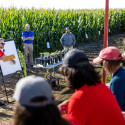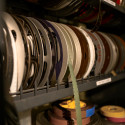Wasp researcher doesn’t mind an occasional sting
Along with picnics, sweet corn and strawberries, wasps usually make an appearance midsummer. While many people recoil at the sight of a paper-like nest tucked under the eaves or behind a foundation crack, a UW–Madison scientist is one of the few who eagerly await the year’s first yellow jackets. He studies how communities of wasps behave, interact and communicate.
“Wasps are really fairly docile,” says Bob Jeanne, an entomologist at the College of Agricultural and Life Sciences. “If you don’t jostle the nest, and if the wind is blowing from the nest towards you, you can actually get quite close to observe them.” Jeanne has studied wasps, both in Costa Rica and Wisconsin, for more than 25 years, and says that the occasional stings he gets hardly bother him.
Jeanne makes summer trips to Costa Rica every couple of years to study a tropical wasp species called Poybia occidentalis, but he also studies Wisconsin wasps, including yellow jackets. “We’ll often collect nests during the summer and keep them in a glass box in the lab,” he says. “There’s a tube to the outside, and we study their foraging behavior and their interactions inside the nest.”
Jeanne’s work has brought insight about the social behavior of wasps, including evidence that yellow jackets rely on odor to find food, and do not appear to transfer information with movement or dances, as honeybees do. For example, when he sets up branched tubes leading from the nest to forage sites, yellow jackets will choose paths that are laced with scents they have learned to associate with food.
Jeanne notes that wasps have several communication strategies, including chemical, mechanical and visual signals, as well as situational cues. For example, “on a dry day, a forager wasp who returns with water might have the water unloaded by a worker wasp right away. That cues the forager there is a high demand for water, and she might decide to get more water immediately.” On the other hand, says Jeanne, if the forager has to wait with her cargo for a minute or two, she might deduce that there is no pressing need for water, and not depart to forage right away.
Overall, Jeanne says, wasp colonies add up to more than the sum of their parts-which the average person on a picnic or in a garden might not realize. “Insect colonies are very complex systems, and as a whole exhibit behavior that cannot be predicted by observing one member of the colony,” says Jeanne.
For example, some species of termites in Africa build giant mounds with tall chimneys, which serve as natural cooling stacks and air-exchange units for the chambers below. However, says Jeanne, “by watching a single termite stick a blob of earth here and there, you wouldn’t predict that the overall structure it is working on will ultimately function as a giant air conditioner.
This summer, Jeanne will use a natural population on campus to study information transfer among yellow jackets. “We have a pretty good relationship with building maintenance at the UW,” he chuckles. “They let us know where the colonies are.” He and his graduate students will place sugar solutions outside wasp nests, and study how colonies allocate foragers to solutions of different concentrations.
While Jeanne says that he finds wasps fascinating, he admits that not many other people share his enthusiasm. “Wasps only sting when provoked, so avoid bumping their nest,” he advises. He adds that organic chemicals in exhaled breath also seem to annoy wasps, “so staying downwind is a good idea.”
Tags: research




